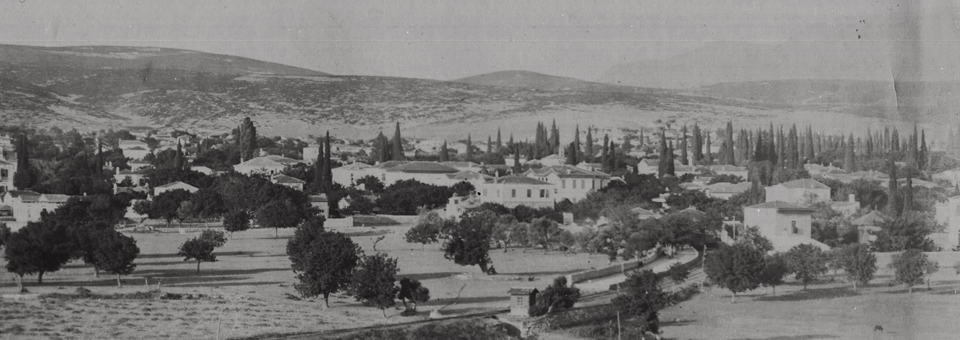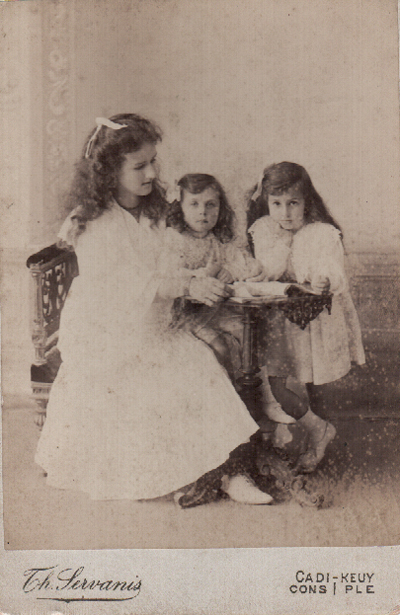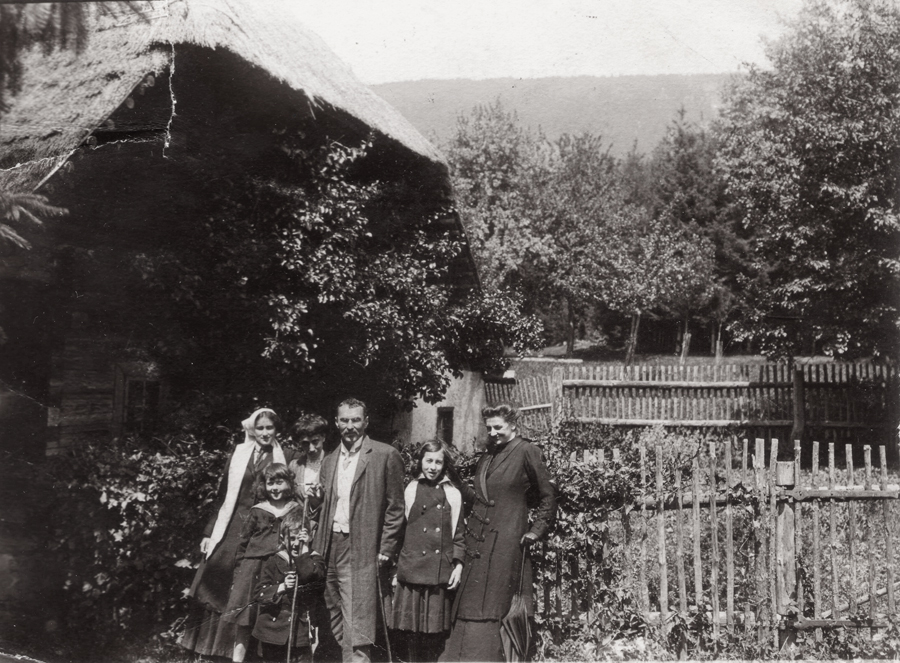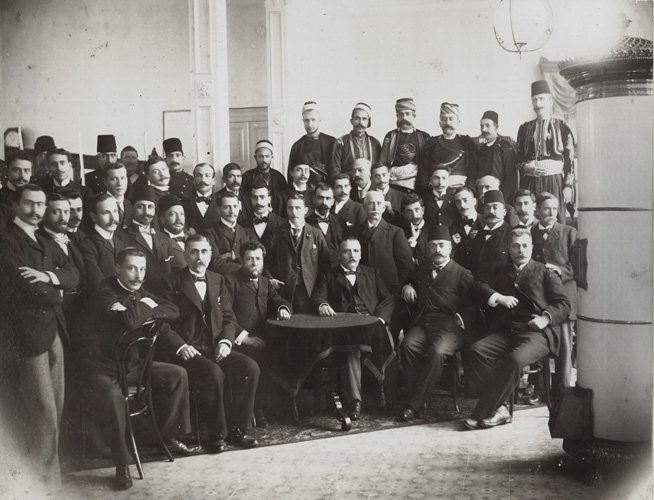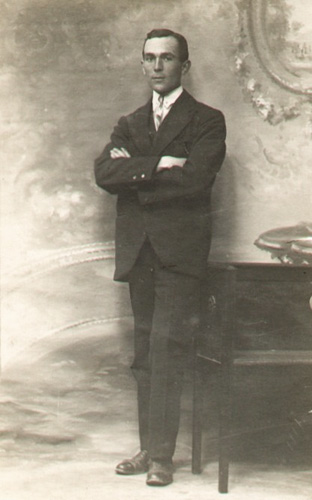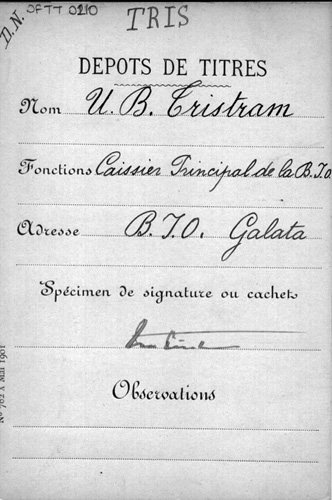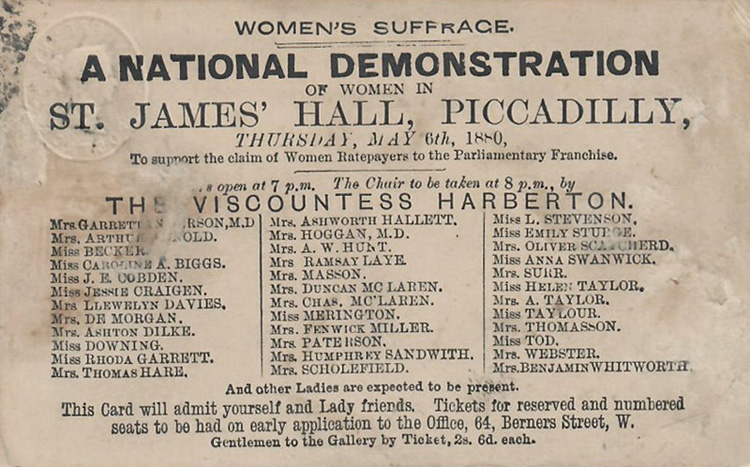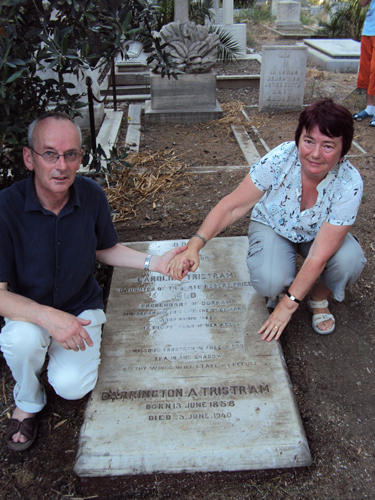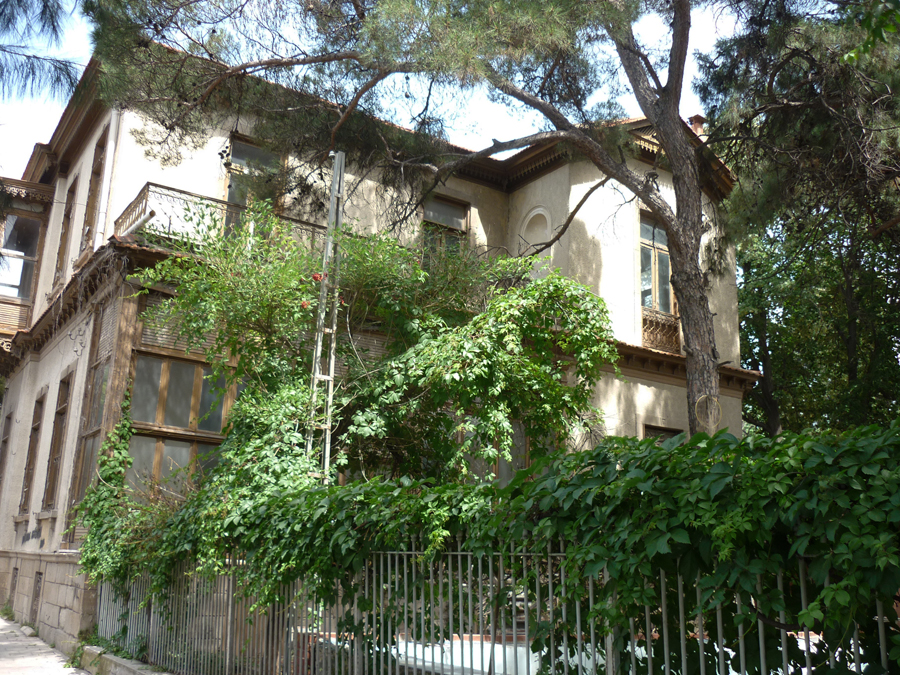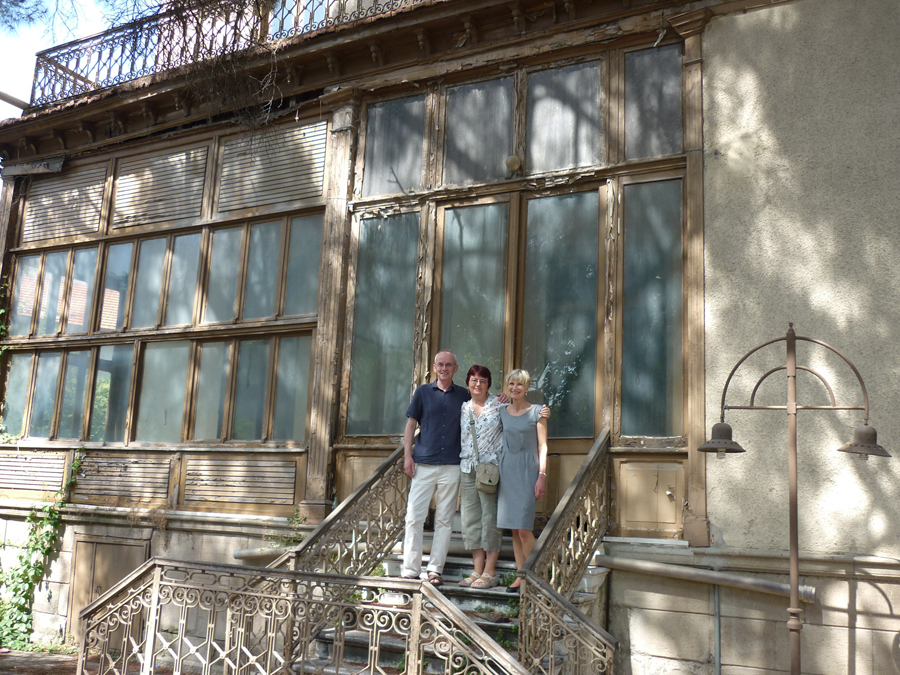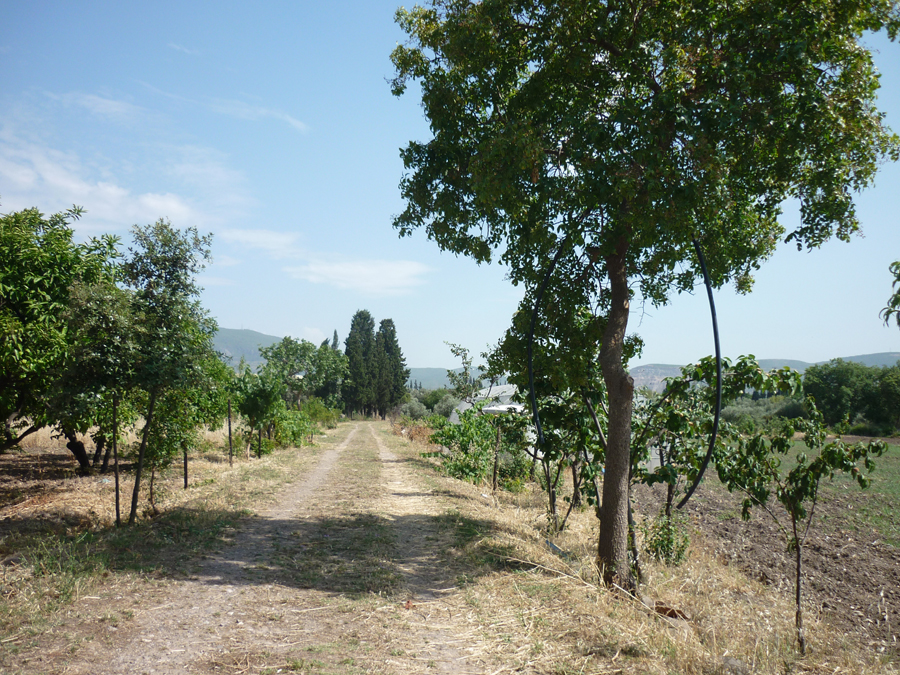
The Contributors
In Search of Tristrams: The Uvedale Barrington Tristram family in Turkey and the Levant
by Elizabeth Knight, great-granddaughter of Uvedale Barrington Tristram (born in Smyrna 7 July 1859) and Marie Cecile Colucci of Cairo (born 1864)

It all began with a small bundle of letters written in careful, beautiful script by two children nearly 150 years ago, and including one from their father to them when he was in Paris. The children were our great-grandfather on our father’s side, Uvedale Barrington Tristram, and our great-grand uncle Barrington Tristram. Their father was also Uvedale Barrington Tristram, born in 1826. The earliest letter was dated 1866, the last 1870. At the top of some of the letters was the only indication of an address: the name Bournabat.

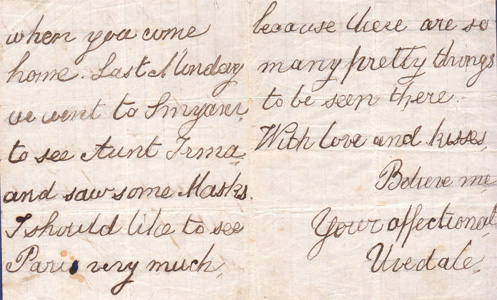
My brother Peter Knight came upon this little bundle in December 2009 in the family archive given to him (after the death of our mother in 2008) by our father Denis (Denis John Uvedale Knight - further info)
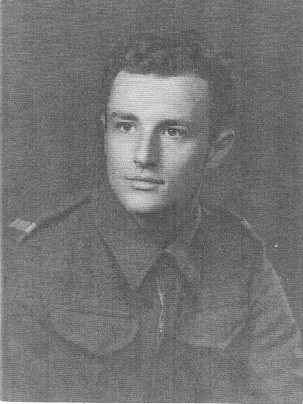
Denis in 1942, Desert Rats
In this way we discovered that our family had once lived in the then Bournabat, Smyrna, as part of the English Levantine community there. Our collection of very old family photographs, which our father had somehow preserved through all the years, the war, and all the moves, travel and family upheavals, suddenly took on a new aspect.
Investigating further, Peter came across the Levantine Heritage website, and through the research done by the late Alex Baltazzi (see Alex’s contribution, Note 54, footnote no.9 on this website) and Rhiannon Boardman, discovered that the former family home, Tristram House, is still standing in present-day Bornova.
In January 2010 I went to Izmir with my then husband to look for it. It was not easy to find, as no-one in the vicinity knew it by name; the Tristrams, it seemed, were all but forgotten. But on a dark cold rainy day suddenly lifted by my delight, we found the house: empty, dilapidated, but standing and still beautiful.
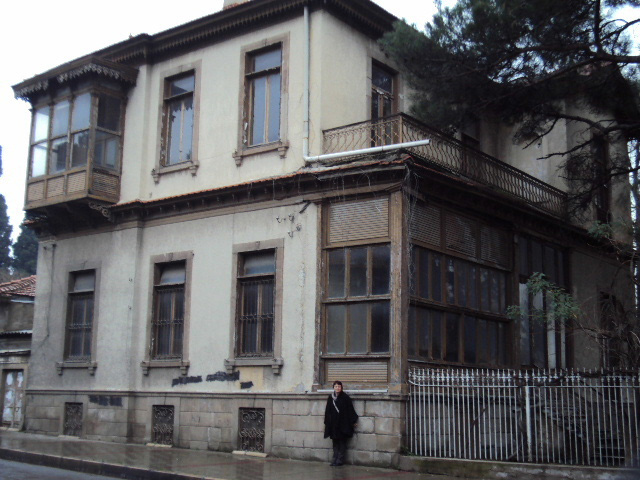
Tristram House, Jan. 2010
Who the Tristrams were
Although our father (who died in 2014) seldom spoke very much about his family past, we knew already that a number of our ancestors had been born in Turkey and the eastern Mediterranean, some in the then Smyrna, some in the then Constantinople, one in Samson and one in Mytilini, my father himself having been born in Volos, Greece
We also knew that that side of our family had for a long time lived in and maintained a strong connection with Turkey and the Levant, beginning in Beirut in the early 19th century.
On our paternal grandmother’s side, they were descendants of the Uvedale Price family of Herefordshire, themselves descendants of Edward lll and the Plantagenet kings through the line of George, Duke of Clarence, and were landowners some of whom became involved in law, diplomacy and banking. (See: The Plantagenet Roll of the Blood Royal).
Our great-great grandfather Uvedale Barrington Tristram (snr) (1826 – 1898) (see Photo 5: U.B. Tristram Snr) was married in Smyrna in 1852 to Dermina (Maria Sophia Dermina) Edwards of Smyrna (1837 – 1899: daughter of Dr Joseph Edwards - see Photo 6 - and Elisabeth Marcopoli). According to our cousin Barrington John Tristram, our great great great grandfather having sold the family estate at Belbroughton, Worcestershire, and the constitution of his eldest son Uvedale being considered “delicate”, he (Uvedale) and some if not all of the family had left England in the early 19th century to stay in the Levant “for his health”. From then onwards, the family roamed the world.

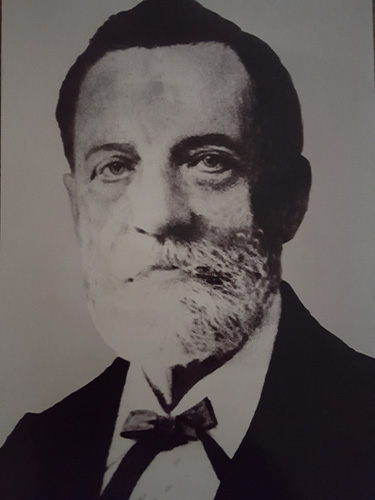
Uvedale Barrington Tristram Snr married to Dermina Edwards of Smyrna / Dr Joseph Edwards father of Dermina Tristram nee Edwards
In spite of this rumoured “delicate health”, Uvedale Barrington and Dermina had ten surviving children (out of 16): Barrington, Uvedale Barrington (our great-grandfather), Charles Francis, Henry Barrington, Lily, Marian, Helen, Blanche, Edith, and Caroline (our great-great aunts and uncles). See Descendant Chart Uvedale Barrington Tristram (Snr).; and the Tristram children in 1860’s and 70’s).
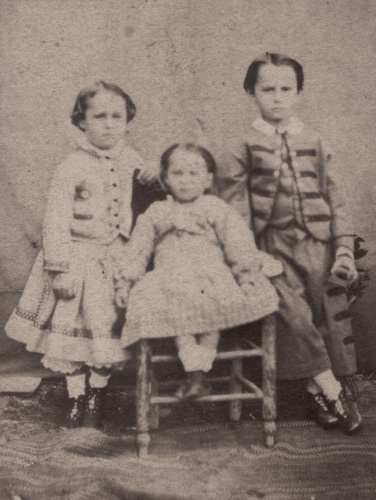
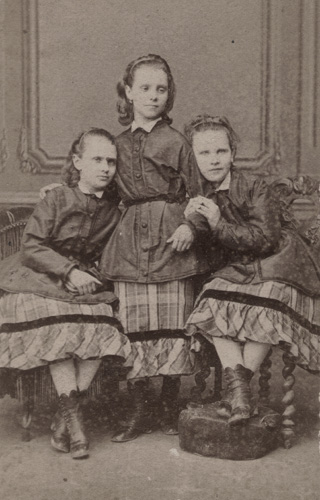
From left: Emily (known as Lily), Marian or Helen sitting, Uvedale Barrington - in mid 1860s, probably in Bournabat, Smyrna. / From left: Marian, Emily (Lily) standing, Helen - in early 1870s, Paris.
Of these children (order as recorded on the Plantagenet Roll of the Blood Royal, not by date of birth):
The first, Barrington A. Tristram, (born 1858), married Irma Barry in 1889, and they had four children: Uvedale Barrington (born in Mytilini in 1892), Roy (born in Smyrna in 1904), Evelyn (born in Constantinople 1890), and Helen (born in Smyrna 1900). This Uvedale Barrington, sometimes known as Uvedale of Alexandria, married Ester Maria Braggiotti (born 1897) in Bournabat, Smyrna, in 1917, and they had three children: Lucy, May and Enid. (See Postscript below : Update on Tristrams in Bornova: Tristram Houses).
The second, Uvedale Barrington Tristram, our great-grandfather, (born 1859 in Smyrna, died 1926), married twice. His first marriage (in Cairo 1887) was to Marie Cecile Colucci, born in 1864, daughter of Riccardo Colucci, the Italian Consul and Anais de Regny - a short biography of our shared great-great grandfather on the Colucci side, Consul Riccardo Colucci, by Edoardo Gautier.
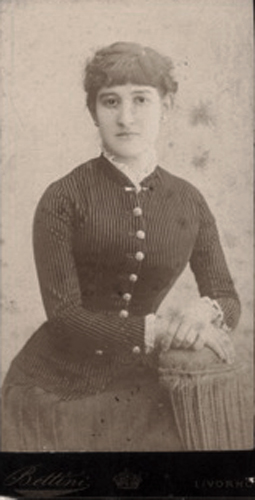
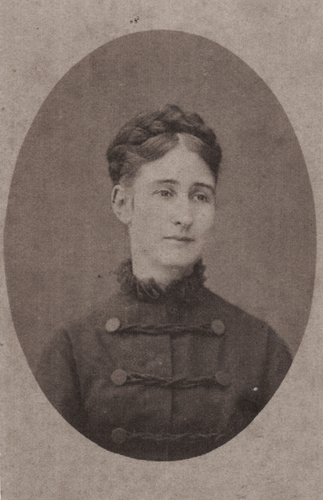
Marie Cecile Colucci in Livorno as a young girl / Marie Cecile Colucci in Cairo after her marriage in 1887
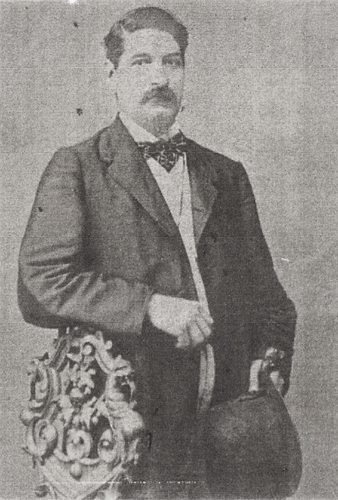

Riccardo Colucci our great great grandfather / Leonce Colucci our great grand uncle in 1857
Sadly, Marie Cecile died in May 1888 shortly after giving birth in Cairo to our grandmother, Marie Cecile Florence, always known as May (1888 – 1969).
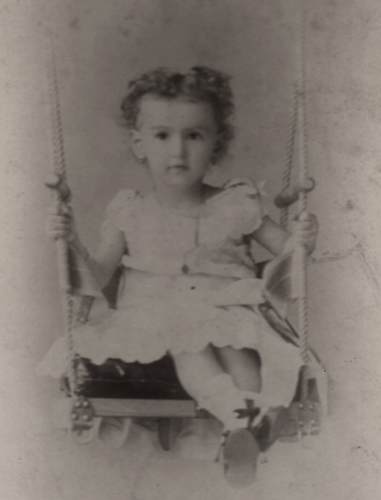
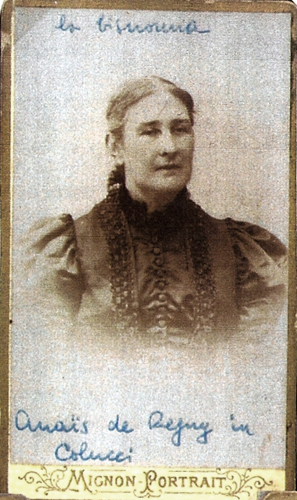
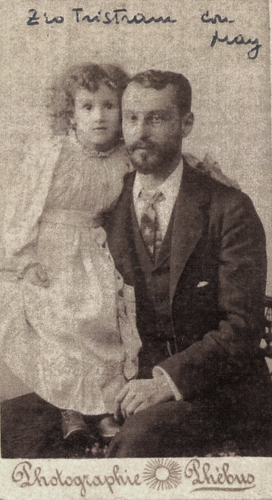
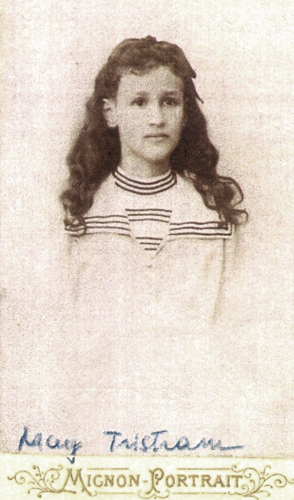

Marie Cecile Florence Tristram known as May as a baby in Cairo c. 1889 / Anais de Regny Colucci - May as a child with father Uvedale - May alone - May with her grandmother Anais de Regny.
Uvedale was working in the Ottoman Bank in Cairo at that time.
Uvedale’s second marriage (in Constantinople in 1897) was to Edla Guarracino (daughter of Horace Bronte Guarracino of Constantinople) - newspaper column in the Levant Herald and Eastern Express newspaper, 1897.
There were four more children from this marriage: Vivian (“Viv”), Phyllis (“Flick”) and Gerald (all born in Constantinople between 1899 and 1904), and Uvedale Francis Barrington Tristram (known in the family as “Uvy”), who was born much later, in March 1915, in Kingston, Surrey.
May with her sisters in Constantinople 1904, from left to right: May, Vivian and Phyllis - hover image to see reverse.
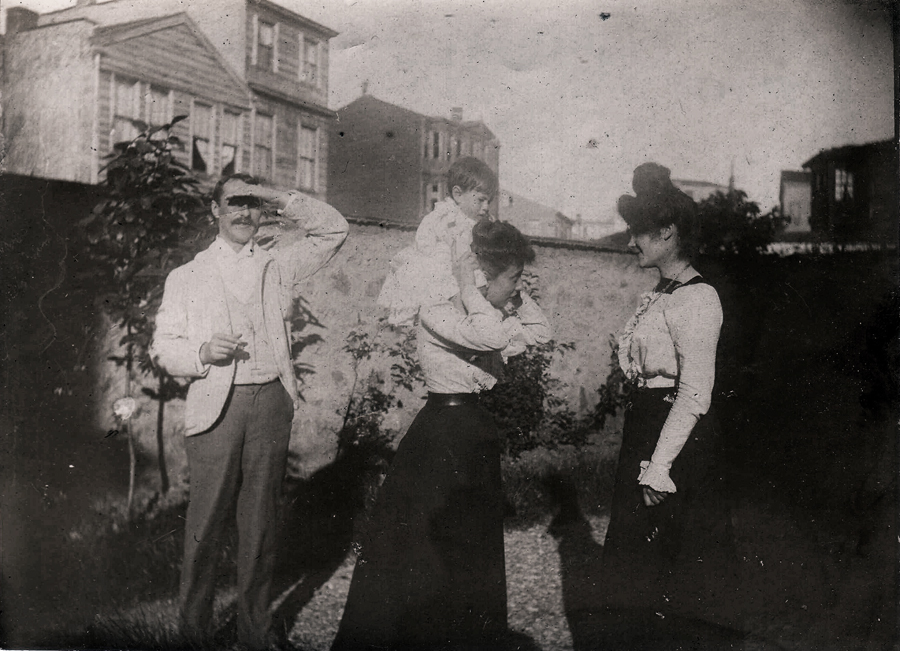
From left: Uvedale Barrington with wife Edla, carrying child (possibly Vivian, born 1899 in Constantinople), young woman unknown - in May 1900, probably in Constantinople.
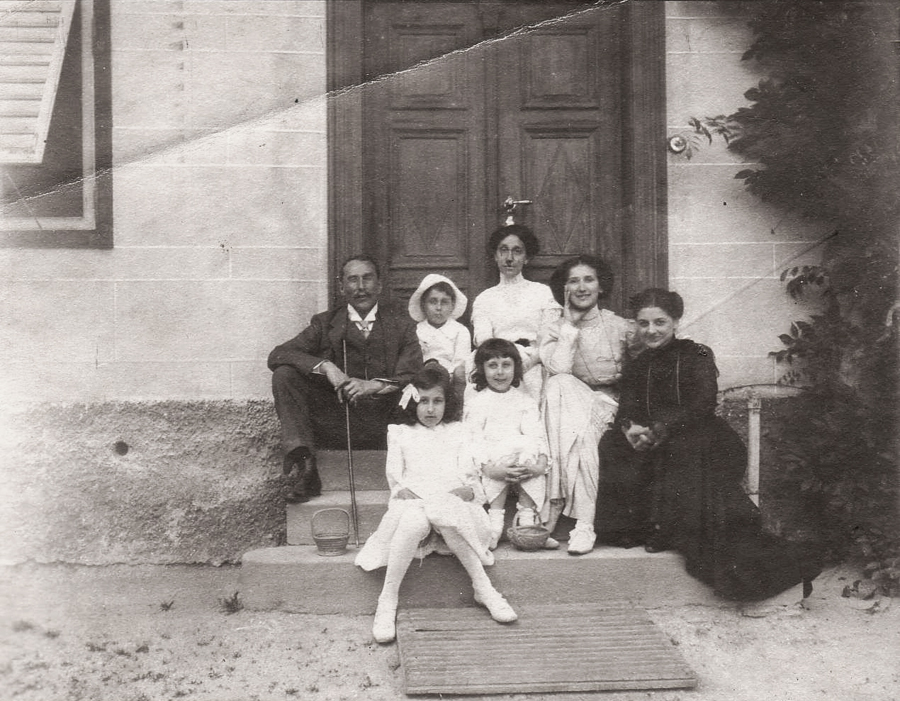
From left: Uvedale with wife Edla, in centre, Alice (May’s aunt) on far right, and children: May, fourth from left, Vivian, front, Phyllis behind her, and Gerald at the back - on house steps
From left: May, her father Uvedale with Edla, second from left, aunt Alice on far right, and the younger children: Phyllis in front of May, Gerald and Vivian - in large garden, about 1910. We believe all these photos were taken in Turkey, but, (except for captioned: May with her grandmother Anais de Regny), whether in Smyrna or Constantinople we do not know.
We know that during this time, great-grandfather Uvedale was working as Chief Cashier of the Imperial Ottoman Bank in the then Constantinople. The Ottoman Bank archive catalogue confirms his being there in 1897, and on the bank notes of Mehmed Resad’s reign, we can see Uvedale Tristram’s signature right up until 1914.
(The Ottoman Bank Headquarters in Istanbul, with a photo of staff in 1893, which may possibly include Uvedale on the far left, standing - Uvedale photo and signature card from the Ottoman Bank archives. The first two photos, along with some other references to our great grandfather, are to be found in Osmanli Bankasi Tarihi, by Edhem Eldem ISBN 975-333-111-8, and our thanks are due again to Alex Baltazzi for finding this reference for us).
The third, Charles Francis Tristram, (born in Smyrna 1865) married Mary Guarracino (sister of Edla, above) in Constantinople in 1895. Charles Francis Tristram was a civil engineer who built railways all over the world, in China, Russia, South America and Africa, as well as Greece and Turkey.
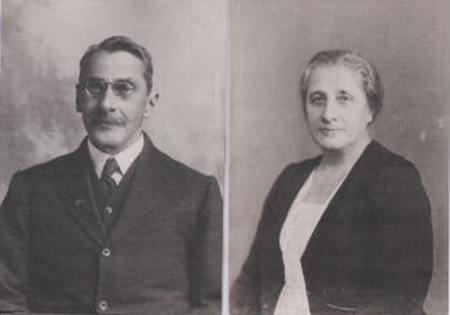
Charles Francis Tristram & Mary Guarracino c. 1930
They had six children: Eric Barrington (born in Smyrna in 1896), Cecil Uvedale (born in British North Borneo in 1900), Wilfred (born in Constantinople in 1902), Winifred Mary (born in Lamia, Greece in 1903), Edmée Mary Lily (born in San Stefano, just outside Constantinople, 1905), and Uvedale Charles (born in Wimbledon in 1913).
Eric Barrington volunteered for foreign service at the outbreak of World War One and was killed near Ypres in 1917 while serving with the 1/5th Bn Lancashire Fusiliers - further information. Cecil Uvedale married Marjorie Davies in 1922, and they had two children. (Their son Barrington John is now the senior member of the remaining Tristram family keeping the name). Cecil Uvedale served in the RAF in the 1920s, but his main career was in Nigeria in the Colonial Service. Wilfred worked for Westminster Bank and remained unmarried. Winifred married Denis O’Callaghan in 1932, and they had one daughter. Edmée Mary Lily taught dancing in Cambridge and London until she married William (known as Bill) Francis Hayes Newington in 1935 and they had three children. Uvedale Charles was in the Palestine Police, and later the Gold Coast Police in Accra, West Africa. He married Jean Mary Fraser in 1943. They also had three children but Uvedale died in a drowning accident on the 16th March 1947 just before the youngest was born. - (See Postscript below: Finding Tristram Cousins in the Present).
The fourth, Henry Barrington Tristram, (born 1879) remained unmarried.
The fifth, Lily Tristram, (born in Smyrna 1860) married into the Whittall family (she married Alfred Whittall in Constantinople in 1885), and they had two children: Eva (born in Smyrna 1886 - more information) and Enid (born in Samsoun 1900).
Eva Whittall in Constantinople - further info:
The sixth, Marian Tristram, (born 1862) married into the Cumberbatch family (Arthur Cumberbatch in Constantinople in 1892), and they had five children: Noel, Leslie, Thelma, Lilian and Melita (all born in Constantinople between 1894 and 1903).
The seventh, Helen Tristram, (born 1863 in Smyrna) remained unmarried.
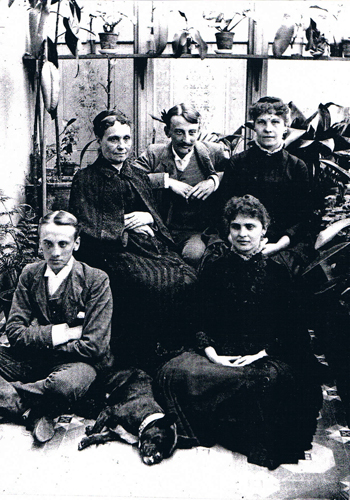
From left to right clockwise: Dermina Tristram nee Edwards; Dick Edwards - Dermina’s nephew; Helen Tristram; Marian Cumberbatch nee Tristram; Joe Edwards - nephew; photo taken on visit to England c. 1887.
The eighth, Blanche Tristram, (born 1872 in Paris) married Charles O’Connell Hayes of the then Port Elizabeth, Cape Colony, in 1898, and they had three children, Hilary Anthony, Kevin O’Connell and Claude Benedict (born in 1901, 1903 and 1906 respectively).
The ninth, Edith Tristram, (born in Paris 1873) remained unmarried.
The tenth, Caroline Tristram, (born 1876 at St Jean de Luz, France) married John (Johnny) Sainsbury Gilbert of Bayswater, London in 1898, and they had nine children, all born in England between 1899 and 1911: Germaine (became Rev. Mother Imelda), Marjorie (married name MacSwiney), Blanch (became Mother Felicity), Nancy (married name Peek), Mary Helen (Molly - became Mother John), Joyce (married name Conner), Tristram (the only boy), Christine (became Sister Lioba), and Millicent (married names 1. Ford (killed in action) 2. Nicholson).
How long were they in Turkey?
1852, the date that our great-great grandfather married Dermina Edwards in Smyrna, seems to be the earliest verifiable date that the Tristrams were living in Smyrna. The last recorded birth of a Tristram in Smyrna is in 1904, and is that of Roy Tristram, the third generation (to my brothers, first cousins and me, our first cousin twice removed), and a son of Barrington Tristram and Irma Barry (above). This means that the Tristrams were resident in Smyrna for at least fifty years – or eighty if our great grand uncle Barrington A. Tristram (born 1858) was a resident when he died and was buried there in 1940.
The dates, birth-places and extant letters seem to indicate that of our great-grandfather’s siblings, those born between 1858 and 1863 certainly grew up in the family home in Bournabat. The younger ones may well also have done so, although they were born in France. We know from the children’s letters that their parents often travelled abroad, especially to Paris, but this does not preclude their main home having remained in Bournabat.
They also often went to Constantinople, and it seems very likely that they had another home there. Many of our great-grandfather’s generation and the following one seem to have had a strong connection with Constantinople, some of them being born and/or marrying there. As we have seen, our great-grandfather worked for many years in the Ottoman Bank there, as did, according to the Ottoman Bank archive, his brother Barrington A. Tristram.
Dermina also visited England occasionally, possibly staying for quite long periods there. UK census records from 1851 - 1901 (compiled by Joyce Cully in 2011) of people living in England who gave their birthplace as Smyrna, Turkey, include mention of Dermina, some of her children and her Edwards family nephews as staying in Kensington, Paddington or Worthing, Sussex at the time of both the 1881 and 1891 census. A collector (Martin Last) sent us the postcard (see below) which is addressed to Dermina in London and is a rare specimen of an invitation to one of the very earliest women’s suffrage meetings, held in Piccadilly in 1880 - also an indication of the kind of political interests and contacts Dermina may have had at the time.
Demonstration invitation 1880 - hover for back of card
Our great-grandmother, Marie Colucci, being Italian, as were both of Uvedale’s wives, the family also kept up a strong connection with Italy, especially Bologna, which was where our grandmother’s (May’s) relatives came from.
From left: unknown relative, May’s aunt Alice (sister of May’s deceased mother Marie Colucci), and May on far right - in Bologna, Italy, date unknown.
When did the Tristrams leave Turkey for the last time?
In a letter to my father Denis written by his aunt, Vivian Tristram, in1992, she says: “The whole family had to leave Turkey in 1914 because of the war, and after a terrible journey…”
According to an account written by Arthur Cumberbatch, husband of Marian (nee Tristram), he and Marian went on recommendation to Odessa when Turkey sided with Germany at the end of 1914. (Marian died and was buried in Odessa in 1917). According to the same account, our great-grandfather Uvedale Barrington and his second wife Edla, together with Lillian (daughter of Marian and Arthur), and presumably all their children, including Vivian (above) also left Turkey for England at the same time. They are recorded as living subsequently at 3 Fasset Road, Surbiton, Surrey, where Uvedale Barrington died in 1926.
However, we wonder if the whole family really did leave Smyrna, Constantinople and Turkey altogether at this point, or whether, as seems likely from the evidence, at least some remained. We do know for certain that if they left, several including Barrington and Roy, returned later.
Barrington was still working at the Ottoman Bank in Constantinople in 1920, according to their archive, and as we know, died in Turkey in 1940, his grave being in Izmir in the Anglican Cemetery (see below).
We know from Andrew Mango that Roy (known in Turkish as Izmirli Roy = Roy from Izmir) was still in Turkey after this time, working with him in Ankara at the British Embassy as assistant Press Attache between 1945 and 47. (He was awarded an OBE in 1946; was Vice-Consul in Muscat in 1954 and in Valparaiso in 1956; he died in Paddington in 1976).
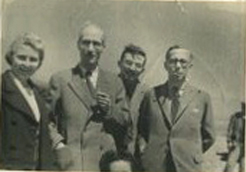
far right, Roy Tristram, with colleagues at Etimesgut, Ankara c. 1945; photo provided courtesy of Andrew Mango, and the reference to Roy in Andrew Mango’s Recollections (on the website).
Our grandmother May Tristram was also to return to Turkey in 1924 with her husband William Lowry Craig Knight when, shortly after the signing of the Lausanne Treaty, he was appointed British Consul in Trebizond (now Trabzon) to help secure the peace and foster good relations with Ataturk’s new democratic and secular Turkey. Our grandfather William Lowry was then appointed - in 1927 - as Second Secretary at the British Embassy in Istanbul. He had already been Vice-Consul/Consul-General in Salonica, Volo and Corfu, (and later was to be Consul/Consul-General in Alexandria, Tunis, Basra and Athens). It was he who wrote the Knight Memorandum at the Foreign Office in 1941 recommending – unsuccessfully in the end – the return to Greece of the Elgin Marbles - (See: WLC Knight in Trabzon and The Foreign Office in 1941).
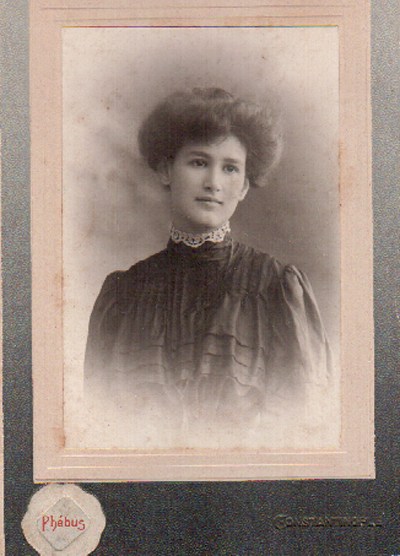

May Tristram and WLC Knight.
Our grandfather’s postings meant that our father, Denis, and his siblings Brendan, Rosemary and Monica, all spent most of their childhood and young adulthood in Turkey, Greece and the Eastern Mediterranean (and kept idyllic memories of it).
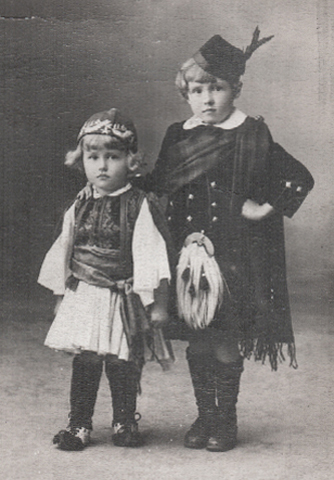
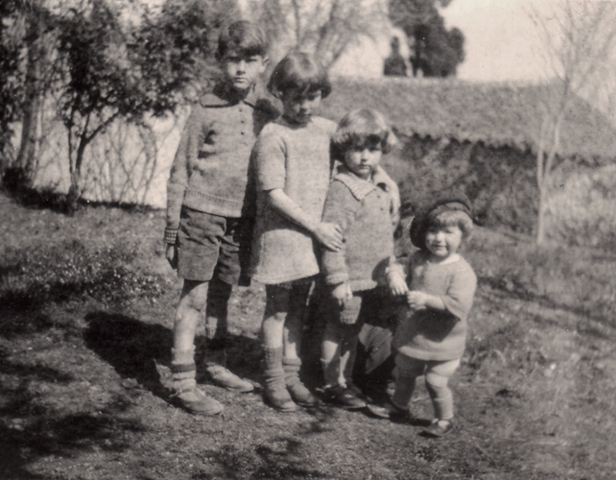

Denis & Rosemary Tristram Knight in Corfu c 1923; Tristram Knight children in Trebizond c 1924; Brendan & Denis in Prinkipo c 1930.
(See: Memories of the Tristram Family in 1920s Istanbul by Monica Douglas nee Knight, and: The Black Sea: poem by Denis Knight).
And now…
In trying to discover more about this side of our family, we have, with the help of the Levantine Heritage website and its researchers, had some adventures and come across some other interesting details.
One avenue was through the researcher Eda Özmutaf, who found the newspaper report of our great-grandfather’s wedding to Edla Guarracino in Pera in 1897. We thank her for this.
Another was through the writer and contributor to this website, the late Andrew Mango, who sent us some very interesting personal reminiscences and photos of our cousin Roy Tristram, for which we thank him.
Our excitement about the search inspired my cousin Frances (daughter of Rosemary) and me to spend a sunny week in April 2010 visiting the old former estate of the early Uvedale Prices in Yazor, Hereford, and the ancient little church as well as the family chapel where they are buried.
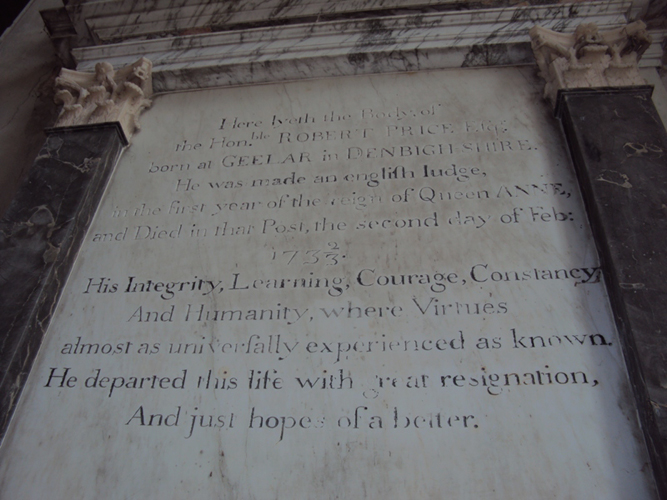
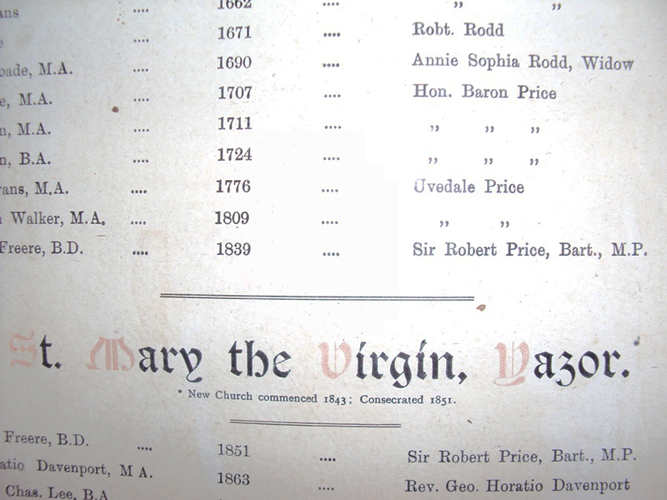

Yazor Church commemorative plaques and burial sarcophagi of Uvedale Price family.
And in May 2010 my brother Pete, sister-in-law Jo, my then husband and myself went to Izmir to see again the former family home in Bornova, and also to track down in the Anglican Cemetery the two Tristrams who, we had learnt - from the list of burials provided on the website - had their graves there.
After what seemed an age of fruitless searching in the cemetery, it was Jo who, scraping away with her foot the debris of years covering a flat burial stone, deciphered the name Tristram faintly engraved. The cemetery keeper and his son rushed to find water and broom with which to clean the stone, and the names and details were suddenly revealed sharply as if by alchemy.
Buried in one grave were: our great-great-great grandmother, Caroline Tristram, nee Price (1790 – 1862), and our great grand uncle, Barrington A. Tristram (1858 – 1940). We see there is an eighty-year span between their deaths. We know Barrington was born and lived in Smyrna, but of Caroline’s presence and life there we know almost nothing. (Her husband Thomas Barrington Tristram died and was buried in Paris in 1838, so, as Barrington John has recently suggested, it could be assumed that the widowed Caroline then went immediately to Tristram House, Bournabat to join the household of her son Uvedale Barrington Snr.).
Especially interesting to us was to learn that as late as 1940 at least one Tristram, Barrington, was still resident in Izmir – or had in any event chosen to be buried there.
We believe that we were possibly the first family members for the last seventy years to visit the graves, or even to recall that they were there. It felt to us a strange and moving moment. We cut an oleander blossom and laid it there, in memory of and as a message to the people laid to rest there and to a past we had thought almost lost to us.
At the grave of Tristrams in Bornova Anglican Cemetery, Izmir.
Postscript:
Up-date on Tristrams in Bornova: the Tristram Houses
During the period of the Levantine Symposium (Izmir, 3 – 6 November 2010), I learned most of the following about the Tristram Houses from Gwynneth and Brian Giraud, and from Nedim Sonmez, co-ordinator at Ege University Rectory, Bornova.
I later learned more details from the historian George Vassiadis, through his recent interviews with Katherine Creon, descendant of the Dermond family and close friend of the daughters of Uvedale Barrington Tristram of Alexandria (born 1892 in Mytilini).
There were originally two houses in the grounds designated as one plot in the deed copy of 1941, one of which is still standing and which is known on various websites and publications as Tristram House. Gwynneth Giraud remembers that the other house burned down some time in the 1940’s. She herself saw it on fire; it was the house immediately neighbouring Charlie Giraud’s house and garden (this being previously the Balliani house).
The second - now disappeared - Tristram house had been occupied up till that point by these members of the Tristram family: Barrington (our great-grand uncle, brother of Uvedale our great-grandfather), his son Roy, and two young women, May and Enid, who were sisters, being Roy’s nieces and Barrington and Irma’s granddaughters. (There was a third granddaughter, Lucy, but we know little about her. Also we do not know when the grandmother, Irma Maria Barry, died). The girls were the daughters of Uvedale Barrington Tristram of Alexandria (see above), and Ester Maria Braggiotti, and it seems that he (and presumably Ester, of whom we also know little) lived in Egypt, while at least two of the girls remained mostly resident in Turkey, in Bornova. The family were close neighbours and friends of the Giraud family, as well being cousins through having Edwards family ancestors in common.
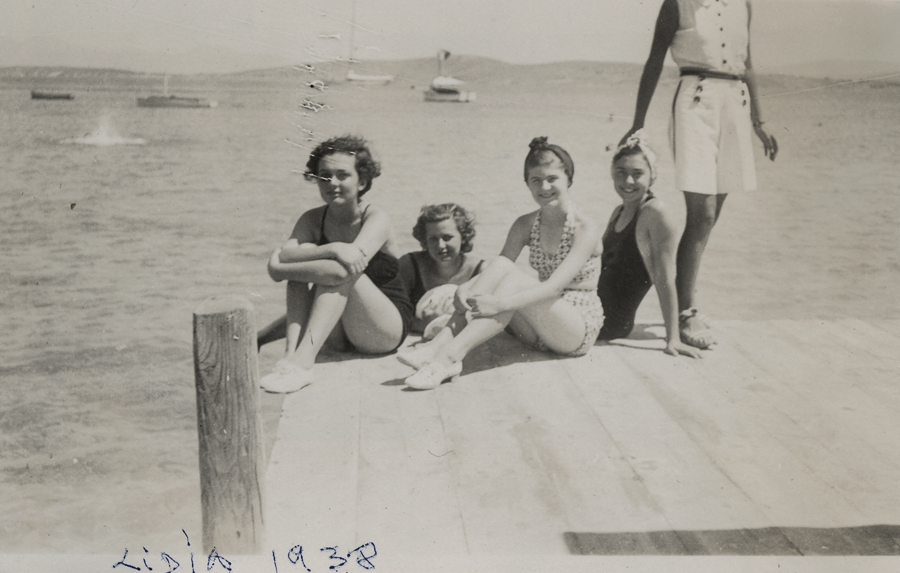
From left: second May Tristram, granddaughter of Barrington, possibly her sister Enid or Lucy, her cousin Gwynneth Giraud (nee Edwards), and far right, sitting, unknown, possibly close friend Katherine Creon - 1938 near Çesme, Turkey.
This means that possibly throughout the Great War and the upheavals of 1922, these Tristrams had remained in Bornova – or they may have left for a few years, then returned.
Barrington died in 1940 and was buried in the Anglican Cemetery in Bornova.
After the fire (we do not know whether this was before or after his death), the Tristram family moved to rented accommodation in the same area, and seem to have moved away out of Bornova – and perhaps out of Turkey to Egypt - a few years later. George Vassiadis records that “Katherine visited the Tristram family in Alexandria during World War Two, when she was serving with the Free French Forces. The father and all three daughters were there, but Katherine doesn’t recall the mother being present.”
The history of the house which remains standing is still a mystery. Gwynneth believes that it was already empty eighty years ago, in the 1930’s, when she was a young woman in Bornova, and that it has not been inhabited since. The Ege (Aegean) University has owned the house and occupied its very extensive gardens for a long while, but we are not sure exactly since when. The Bornova Plant Protection Research Institute is now centred here and the gardens are in use for botanical research.
There is no doubt that this house, still known as Tristram House, is in the Tristram grounds and must have belonged to the family. Possibly it was formerly home to Barrington’s brother, our great-grandfather Uvedale, who we know was born in Smyrna (in 1859) and his family; or it could have been the home of other brothers or sisters (he had nine). Possibly Uvedale left the house (and it may have been sold) when he started working at the Ottoman Bank in Constantinople (probably in 1897); although it may have been lived in by other family members or used as a second home during or after that time.
In any event, either this house or the one which burnt down must have been home at one time or another to our great-great grandparents, Uvedale Barrington Tristram and Dermina Edwards (married in Smyrna in 1852), as we have the letters from their children written in Bournabat which show this.
Tristram House and gardens in May 2010 - further images:
My grateful thanks to Gwynneth and Brian Giraud for talking to me about this and about our mutual family connections, and for all their interest, kindness and hospitality.
Also my grateful thanks to Nedim Sönmez, George Vassiadis, Katherine Creon and Freddie Barnes for all their interest, help and kindness.
Finding Tristram Cousins in the Present
The Levantine Heritage website has been the magic carpet putting us in touch with far-flung cousins we would probably never have been able to find otherwise! In the past few years we have made contact with previously unknown (to us) but comparatively closely connected relatives in Turkey, in England, in Belgium, in Italy, in South Africa and in Argentina. Some of these are the descendants of Charles Francis Tristram and Mary Guarracino, others also are descended or related through the Edwards, Guarracino, de Vere, Gilbert, Newington and Cumberbatch families.
It has been wonderful to exchange messages, photographs and family recollections, to fill in many missing pieces in the family tree jigsaw, to add our small contributions to Levantine family history, and where possible to meet face to face. Thank you to the Levantine Heritage Foundation and website, its researchers and its editor Craig Encer, for making this possible.
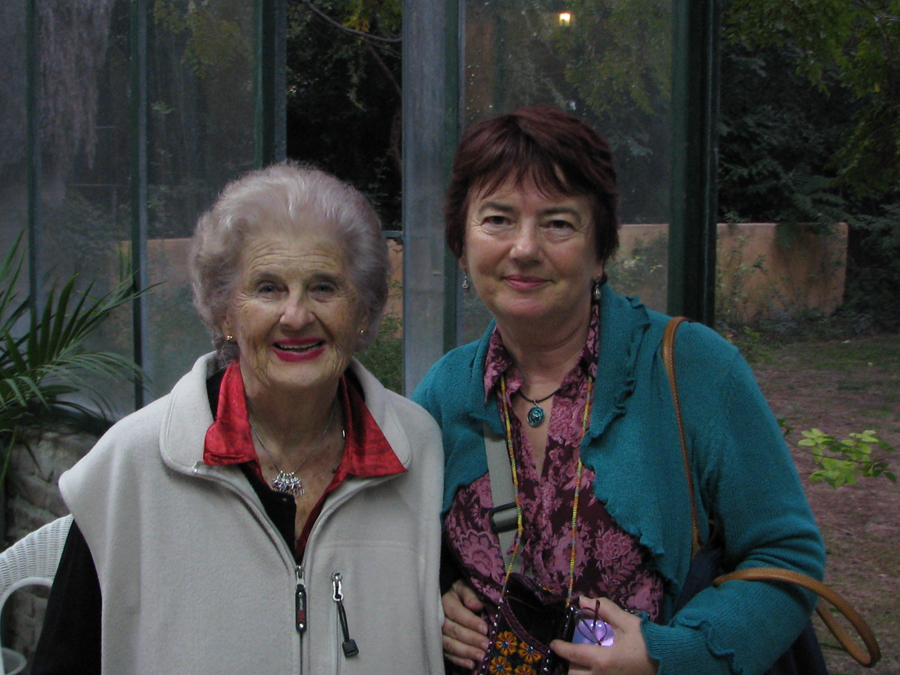
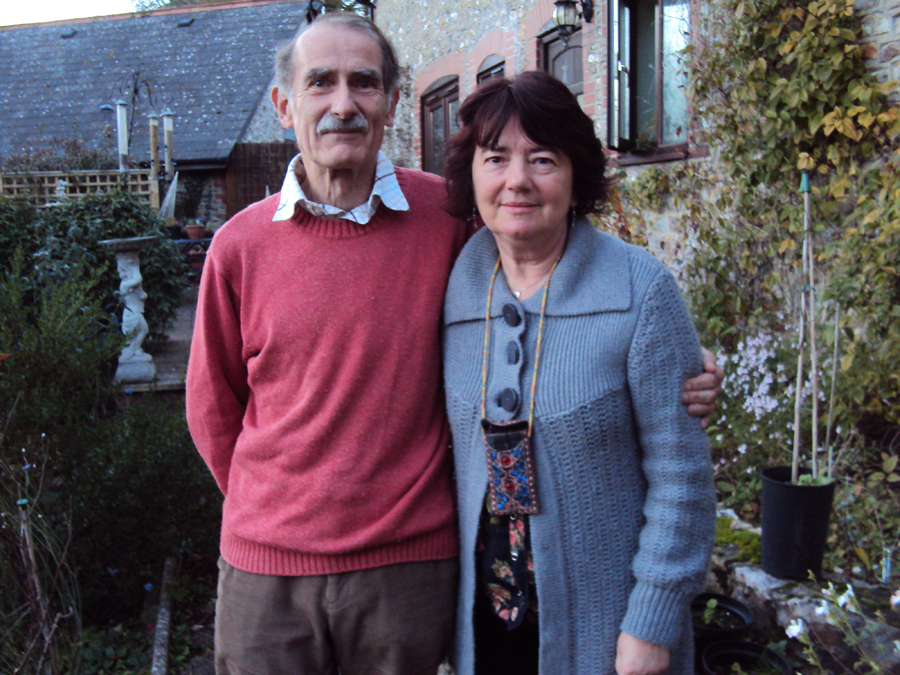
With newly-met cousins in Izmir and in Devon, Gwynneth Giraud and Barrington John Tristram.
Further information on the early Tristam story from Barrington John Tristram
The Tristrams were a prosperous family of Belbroughton in Worcestershire, who had acquired property by judicious marriages to heiresses and had joined the professions of medicine, the law and the Church. Several of the family were Rectors of Belbroughton. In the time of George III the Rev Thomas Tristram married Louisa, only daughter of General the Hon John Barrington, brother of Viscount Barrington, Admiral Barrington and Bishop Barrington of Durham. This family influence ensured that all the sons of Rev Thomas Tristram found preferment: in the Navy, the Army, the East India Company Army, the Church and the Law. When he died in Paris in 1838 the oldest surviving brother, Capt Thomas Barrington Tristram, had sold his Belbroughton estate. He had married Caroline, nee Price, the widow of a family friend, Capt Francis Baker RN.
His only son, Uvedale Barrington Tristram, was considered ‘delicate’ and consequently spent much of his time in the Mediterranean climate. He married the 15-year-old Dermina Edwards, daughter of Dr Joseph Edwards of Smyrna, who had qualified in Italy and had a flourishing medical practice in Smyrna, where he had been brought up. After the wedding Dermina returned to school for a time to complete her education. U.B. Tristram dealt in stocks and shares in London and Paris, but when his partner absconded with the funds he went to live in St Jean de Luz, which provided a convenient escape route to Spain should he be pursued by his creditors. In due course all the debts were successfully discharged but in the early years of the marriage Dr Edwards provided financial support, partly perhaps because the partner who welched was a relative of his. Thanks to Dr Edwards the expanding Tristram family, together with various brothers, half-brothers and cousins of Dermina, lived at different times in Smyrna, Paris, London and Worthing. At one stage indeed the 2 oldest sons when in their early teens stayed with the family of their grandfather’s first wife, the Bakers. Uvedale Barrington Tristram died in 1898 when renting the suitably Ottoman-sounding, and indeed Ottoman-styled, Villa Ibrahim in Nice. He left a significant inheritance which was somewhat eroded after it had been shared between his widow and 10 surviving children.
The sons of Uvedale and Dermina who reached maturity all became part of the Levantine community, finding employment in the Ottoman Bank, the Consular service, or as civil engineers. Of the 3 sons and 4 daughters who married all except Caroline (Lena) the youngest married into families wholly connected to the expatriate communities of the Ottoman and British Empires.
Elizabeth Knight (copyright)
First written in November 2010 in Ayvalık, Turkey; revised in July 2017 in South Brent, Devon. In order to assist Ms Knight in her quest to discover more about her Levantine ancestors, please contact her on: eknight47[at]icloud.com
